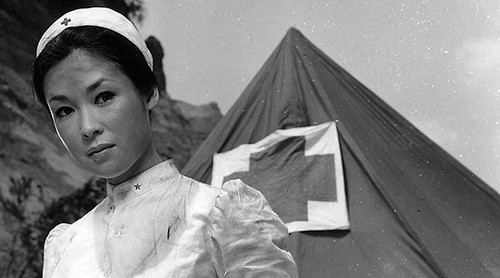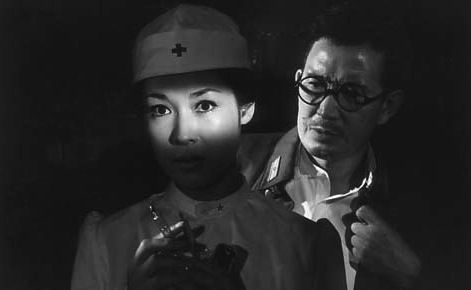Red Angel
July 20, 2022 · 0 comments
by Jeremy Clarke.

An army nurse is sent to China in director Yasuzo Masumura’s Red Angel (1966). Or as a slogan in one of the film’s trailers puts it, “on the battlefield where life and death is decided.”
In 1939, for her first posting, Nurse Sakura Nishi (Ayako Wakao) is sent to Tianjin Army Hospital. A number of the male patients appear to be faking medical conditions so as to escape the front line, where Japanese casualties are heavy. When she first does her rounds, Private Sakamoto (Jotaro Senba) and a number of the other men are very forward and ask her a lot of personal questions. Much worse is to come, however, because when she does her night rounds, she finds herself trapped in the men’s dorm and raped by Sakamoto while the others hold her down. Reporting this incident to the head nurse (Ranko Akagi), Nishi learns she’s this soldier’s third victim. The head nurse resolves to have Sakamoto sent back to the front.
As if all this wasn’t bad enough, Nishi is then posted to a front-line hospital where medics go through the incoming wounded, pronouncing them dead or designating them for surgery, for which read amputation. Army surgeon Second Lieutenant Okabe (Shinsuke Ashida), Nishi’s voice-over informs us, did 200 operations over three days and nights, going without sleep. Sakamoto turns up again among the wounded and recognises her. He could possibly be saved via a blood transfusion, so she pleads to Okabe on Sakamoto’s behalf who informs her that only Colonels and above get blood transfusions. She doesn’t want Sakamoto to think she won’t help him because of his past behaviour towards her and feels guilty when she finds she can do nothing for him after all.

When she visits the doctor at night to discuss this, he orders her to remove her uniform because he feels unable to get drunk in front of a nurse. He later orders her to inject him with morphine because it’s the only way he can sleep… and forget the huge number of amputations he has performed, many of which are on patients who don’t require such draconian measures.
Sent back to Tianjin, unable to get Okabe out of her mind and feeling guilty about Sakamoto’s death, Nishi responds to a request by another soldier Private Orihara (Yusuke Kawasu), who has had both arms amputated, for her sexual favours. Afterwards, after she tells him that this will never happen again, he commits suicide causing her further guilt.
Sent back to the front-line hospital, she is put to work removing bullets from the men wounded by what Okabe describes as “our army cut to pieces”. Overnight, she sleeps beside the impotent Okabe in his room. When he’s ordered to leave the hospital for the front itself, she begs to tag along with him. Thus, they find themselves with a unit cut off by the Chinese and suffering from a cholera epidemic as the tale moves towards its conclusion. Here, she finally initiates physical relations with the morphine-addled Okabe, something of which he didn’t believe he’d be capable given his state, before becoming the sole survivor of a battle with the Chinese.
As well as suggesting blood or flight through a blood-red sky – a somewhat incongruous idea for a film shot in black and white – the title Red Angel invokes two central ideas: one, the idea of the beautiful woman for whom men yearn and, two, the Angel of Death. The “angel… or prostitute?” tag line found in the trailers clearly riffs off the first, as does the scene where the men display their enthusiasm for the rarely seen Japanese nurse when Nishi and others first arrive in the frontline village that will be the setting of the final reel’s battle.

As for the Angel of Death, Nishi believes herself responsible for four deaths, three of them concerning men with whom she’s had sex. The fourth is a junior nurse Tsurusaki (Ayako Ikegami) who is one of those slaughtered in the battle at the end. While you could argue that Nishi offers the three men some sort of redemption to ameliorate appalling war zone conditions, her own voice-over details interior dialogue which makes it very clear that she regards the four deaths as something for which she is personally responsible. In plot terms, she is not directly responsible for any of them – one dies from war wounds, one commits suicide and two are killed in enemy action. Nevertheless, in the character’s mind, her survival to the end of the narrative is lent a bittersweet edge.
This is the fifteenth of the roughly twenty films Yasuzo Masumura made with actress Ayako Wakao, which include Seisaku’s Wife (1965) and Irezumi (1966). In the disc’s 13-minute interview “Not All Angels Have Wings”, US critic Jonathan Rosenbaum cites Red Angel as a good film with which to start on Masumura’s body of work, noting that it was viewing this title that led he himself to embark on seeing dozens of the rest. The best ones, in his view, star Daiei contract actress Wakao and are shot in black and white and CinemaScope (technically Daieiscope – Masumura was under contract to Daiei until that studio’s closure in 1971). Rosenbaum bemoans the fact that the more exploitative films tend to get released outside Japan at the expense of what he considers to be better titles.

Rosenbaum relates Red Angel to a remark by Sam Fuller on his film The Big Red One (1980) that if he’d shown Normandy Beach as it really was, covered with guts and body parts, he’d have driven audiences from the cinema. Masumura’s film certainly doesn’t show the Second Sino-Japanese War as it really was, but its plot doesn’t shy away from the notorious subject of comfort women, and features amputations galore, plus shots of post-op severed limbs in field hospital buckets.
In his commentary track, academic David Desser repeatedly asks the question, what were the Japanese doing in China? Like Hollywood films about the Vietnam War, Red Angel focuses on the plight of national soldiers as victims of conflict. In Red Angel’s field hospitals, the soldiers are dead or subject to arbitrary amputation, while nurses are raped by patients. Ordinary soldiers are shown as sexual monsters who abuse women, so sex-obsessed that they’d will even consider raping cholera victims. By way of contrast, the only doctor in sight feels impotent at saving lives when that so often means hacking off patients’ limbs, often unnecessarily. Okabe’s solace in morphine and that addiction’s attendant sexual impotence, which the angel Nishi sets out to cure, spring from this mental state.
Desser returns to the question, what were the Japanese doing in China? If the enemy are scarcely seen here, only appearing in one or two shots towards the end, the carnage of the field hospitals shown suggests that Japan is fighting a losing battle. In fact, the Imperial Army was gaining ground up until 1942, well after 1939 when the story is set. There is no mention of Japan’s aggressive, militaristic goal of expansion beyond its borders. This lack of acknowledgement of what Japan was actually up to, says Desser, is a problem that besets most Japanese war films of the period, a rare exception being Kobayashi’s The Human Condition trilogy, (1959-61).
As well as the commentary, the Rosenbaum introduction and the obligatory Tony Rayns introduction, in which he discusses the film’s sexual frankness and how Japanese soldiers here do not come off well, the disc also includes two extraordinary trailers. One sells the film as “war… and sex” to two excerpts from Berlioz’ Symphonie Fantastique, Op.14, IV Allegretto, a composition which doesn’t appear anywhere in the actual film. It also includes a shot of Masumura himself directing. The other piles on both sex and dismemberment elements and flags “an unflinching portrayal of war and sex… in a unique and shocking drama!” Both do a good job of selling the film.
Red Angel is out on Blu-ray from Arrow Video. Jeremy Clarke’s website is jeremycprocessing.com
Leave a Reply